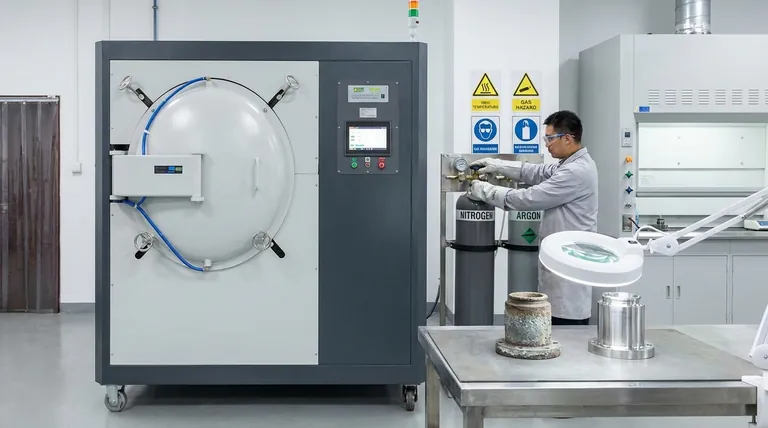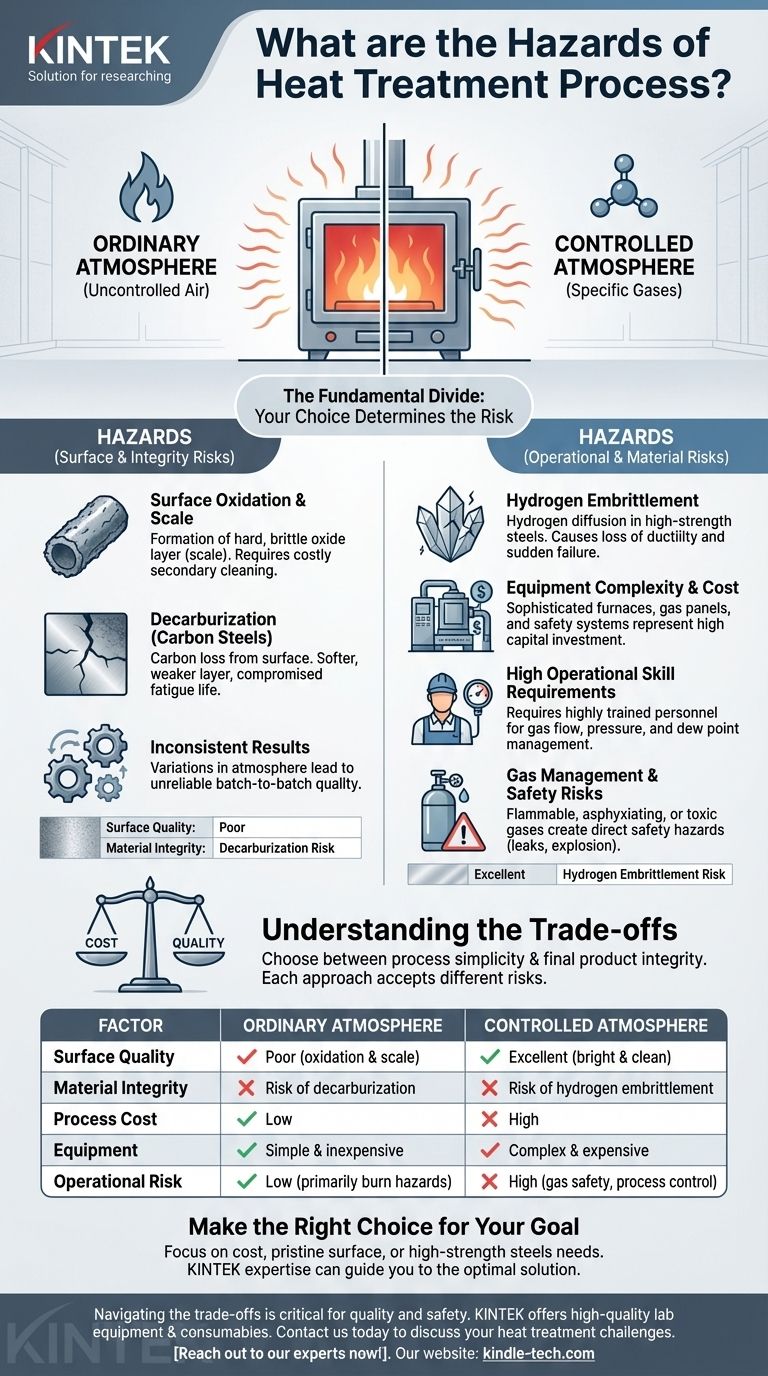The hazards of heat treatment extend beyond the furnace, encompassing material degradation, quality defects, and significant operational risks. The core dangers are not just physical but chemical, stemming from the high-temperature reactions between the metal workpiece and the surrounding atmosphere, which can lead to oxidation, embrittlement, or loss of critical surface properties.
The central challenge in heat treatment is managing the trade-off between process simplicity and final product integrity. While simpler methods are cheaper, they invite surface defects, whereas complex controlled-atmosphere processes introduce risks of material embrittlement and high operational overhead.
The Fundamental Divide: Ordinary vs. Controlled Atmosphere
The majority of heat treatment hazards are determined by one critical choice: whether to treat the workpiece in an ordinary atmosphere (like air) or a precisely managed controlled atmosphere.
This decision dictates the types of chemical reactions that will occur on the metal's surface at high temperatures and, therefore, the primary risks to the final product.
Hazards of Ordinary Atmosphere Heat Treatment
Treating metal in an open furnace or an uncontrolled air atmosphere is straightforward but exposes the material to significant quality risks.
Surface Oxidation and Scale
When heated in the presence of oxygen, most metals form a hard, brittle layer of oxide, often called "scale." This layer alters the part's dimensions, creates a rough surface finish, and must typically be removed through costly secondary processes like sandblasting or chemical cleaning.
Decarburization
For carbon steels, exposure to an oxidizing atmosphere at high temperatures can cause carbon to burn off from the surface. This phenomenon, known as decarburization, leaves the surface layer softer and weaker than the core, severely compromising fatigue life and wear resistance.
Inconsistent Results
An uncontrolled atmosphere is subject to variations in humidity and composition, leading to inconsistent results from one batch to the next. This makes it unsuitable for applications requiring high precision and repeatability.
Hazards of Controlled Atmosphere Heat Treatment
Using a controlled atmosphere of specific gases (like nitrogen, argon, or hydrogen) is designed to prevent oxidation and decarburization. However, this solution introduces a new set of complex operational and material-specific hazards.
Hydrogen Embrittlement
Using atmospheres rich in hydrogen to prevent oxidation can be dangerous for certain high-strength steels. Hydrogen atoms can diffuse into the metal's crystal structure, causing a severe loss of ductility and leading to premature, catastrophic failure under stress. This is known as hydrogen embrittlement.
Equipment Complexity and Cost
Furnaces for controlled atmosphere treatment are significantly more complex and expensive. They require sophisticated gas mixing panels, safety interlocks, and monitoring systems, representing a large capital investment.
High Operational Skill Requirements
Managing gas flow rates, furnace pressure, and dew points requires highly trained operators. An error in managing the atmosphere can ruin an entire batch of parts or, in a worst-case scenario, create a safety hazard like an explosion.
Gas Management and Safety Risks
The gases used can be flammable (hydrogen), asphyxiating (nitrogen, argon), or toxic (ammonia). Leaks in the system pose a direct risk to personnel and facilities, and the storage and handling of high-pressure gas cylinders carry their own inherent dangers.
Understanding the Trade-offs
The choice between ordinary and controlled atmosphere heat treatment is not about which is "better" but which set of risks you are willing to accept. Each approach presents a distinct balance of cost, quality, and operational complexity.
| Factor | Ordinary Atmosphere | Controlled Atmosphere |
|---|---|---|
| Surface Quality | Poor (oxidation and scale) | Excellent (bright and clean) |
| Material Integrity | Risk of decarburization | Risk of hydrogen embrittlement |
| Process Cost | Low | High |
| Equipment | Simple and inexpensive | Complex and expensive |
| Operational Risk | Low (primarily burn hazards) | High (gas safety, process control) |
Making the Right Choice for Your Goal
Your decision should be driven by the end-use requirements of the component and your operational capabilities.
- If your primary focus is cost-minimization for non-critical parts: Ordinary atmosphere treatment is a viable option, provided you can tolerate surface oxidation and potential decarburization.
- If your primary focus is pristine surface finish and preserving material properties: Controlled atmosphere treatment is necessary, but you must invest in the right equipment, training, and safety protocols.
- If you are working with high-strength steels: You must be acutely aware of the risk of hydrogen embrittlement and carefully select an atmosphere with low or no hydrogen content.
Ultimately, understanding these hazards allows you to proactively select a process that aligns with your technical requirements and manage its associated risks effectively.

Summary Table:
| Factor | Ordinary Atmosphere | Controlled Atmosphere |
|---|---|---|
| Surface Quality | Poor (oxidation and scale) | Excellent (bright and clean) |
| Material Integrity | Risk of decarburization | Risk of hydrogen embrittlement |
| Process Cost | Low | High |
| Equipment | Simple and inexpensive | Complex and expensive |
| Operational Risk | Low (primarily burn hazards) | High (gas safety, process control) |
Choose the Right Heat Treatment Process with Confidence
Navigating the trade-offs between ordinary and controlled atmosphere heat treatment is critical for your product's quality and safety. Let KINTEK's expertise guide you to the optimal solution.
We specialize in providing high-quality lab equipment and consumables, including furnaces and atmosphere control systems, to help you mitigate risks like oxidation and embrittlement. Our solutions are designed for laboratories that demand precision, repeatability, and operational safety.
Contact us today to discuss your specific heat treatment challenges and discover how our equipment can enhance your process integrity and product performance. Reach out to our experts now!
Visual Guide

Related Products
- Vacuum Heat Treat Furnace with Ceramic Fiber Liner
- Molybdenum Vacuum Heat Treat Furnace
- Vacuum Heat Treat Furnace and Levitation Induction Melting Furnace
- 2200 ℃ Graphite Vacuum Heat Treat Furnace
- 2200 ℃ Tungsten Vacuum Heat Treat and Sintering Furnace
People Also Ask
- What materials are used in a vacuum furnace? Selecting the Right Hot Zone for Your Process
- Why do you vacuum for heat treatment? Achieve Flawless, High-Performance Metal Components
- Can I vacuum the inside of my furnace? A Guide to Safe DIY Cleaning vs. Professional Service
- What materials are used in a vacuum furnace? A Guide to Hot Zone Materials and Processed Metals
- What are the advantages of a vacuum furnace? Achieve Superior Purity and Control in Heat Treatment



















